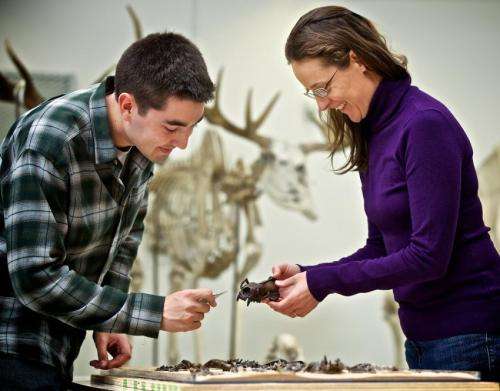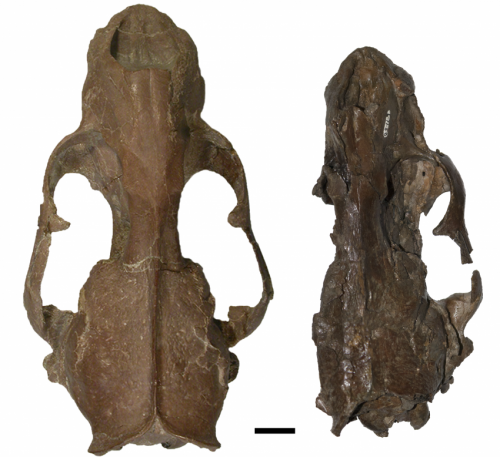Graduate student makes major discovery about seal evolution

In the world of science, one of the most exciting things a researcher can do is pin down an answer to a widely asked question. This experience came early for Carleton University graduate Thomas Cullen, who made a discovery about pinnipeds—the suborder that makes up seals, sea lions and walruses—while doing research for his Master's degree under the supervision of Canadian Museum of Nature palaeontologist Dr. Natalia Rybczynski.
His discovery, published the journal Evolution, relates to sexual dimorphism (a large variance in size between males and females), in a variety of pinniped species. Males in many species of pinnipeds are often much larger than their female counterparts, in some cases more than twice as large, and this has implications for how they mate and behave.
Dimorphic pinnipeds such as the Steller's Sea Lion and Northern Fur Seal typically mate in a harem, with one male pinniped presiding over a larger community of female mates. This behaviour is not typically seen in non-dimorphic pinnipeds such as the Ringed Seal, and so sexual dimorphism is intimately linked with mating style.
Researchers have long puzzled over both why sexual dimorphism exists in many pinniped species and when this trait evolved. When Cullen examined fossils of an extinct pinniped with Rybczynski, he discovered an incontrovertible answer to the question of when. He was able to examine it there before analyzing the data at Carleton in a lab headed by his other thesis supervisor, Prof. Claudia Schröder-Adams.
"We were examining a fossil of a pinniped that was previously thought to be a juvenile, but we looked at it again and found that, based on its skull structure, it was likely an adult," says Cullen. This discovery, coupled with analyses comparing this fossil to others of the same species as well as modern dimorphic species, proved that the fossil belonged to a sexually dimorphic species.

The fossil in question, the skull of an early pinniped ancestor called Enaliarctos emlongi, was discovered in the late 1980s off the coast of Oregon. During Cullen's time at Carleton, it was housed at the Canadian Museum of Nature, while on loan from the Smithsonian Institution in Washington, D.C.
After analyzing the fossil in relation to modern seal skull structure with the assistance of Carleton PhD candidate Danielle Fraser, Cullen found the evidence suggested that sexual dimorphism existed in seals somewhere between 20 million and 27 million years ago, near the base of all pinniped evolution and much longer ago than was previously thought. Cullen became one of the first researchers to pin down a timeline for the phenomenon. The discovery has implications for the past and future of the species.
"Early pinnipeds likely formed harems, the way a sea lion would," says Cullen. "Up to this point, it was not widely expected that early pinnipeds would behave this way."
Once Cullen and his team addressed the question of when sexual dimorphism in pinnipeds evolved, he was able to turn to the question of why it happened.
"Our interpretation is that these changes were happening at a time when the Earth was experiencing major climate and ocean circulation changes. Harem colonies were likely located at ocean upwelling sites that concentrate nutrients in otherwise nutrient-poor water. We think that this environmental factor, this concentration of large numbers of pinnipeds into one area, pressured them into developing the harem mating system and sexual dimorphism."
Cullen's finding sheds light on the history of pinnipeds, but when taken in the modern context of climate change, it has major implications for the future of the species.
"Climate change today appears to be having an effect on the Arctic and Antarctic more than on the temperate and equatorial latitudes. Most Arctic and Antarctic pinnipeds aren't really sexually dimorphic, and we think this is because the water in those areas is quite nutrient rich. The pinnipeds there didn't have that selection pressure to form harem behaviour because of the wide availability of nutrients. Going forward, if the effect of climate change is increased water temperature in the Arctic and Antarctic, it would suggest that the nutrient levels will be reduced. This could put more pressure on pinnipeds in the polar regions areas to form colonies and, as a result, harem behaviour."
Cullen's research presents some of the earliest evidence in marine mammals of what Charles Darwin wrote about when positing his theories of sexual selection in evolution. There has been a relative lack of new data on sexual dimorphism in the fossil record until now.
"This paper shows that the fossil record can be really useful in answering evolutionary questions that could otherwise not be addressed," says Cullen. "It also shows that a combination of modern and fossil analysis is crucial to thoroughly addressing evolutionary problems. We were really lucky to have access to a specimen of this nature."
More information: onlinelibrary.wiley.com/doi/10.1111/evo.12360/full
Journal information: Evolution
Provided by Canadian Museum of Nature



















